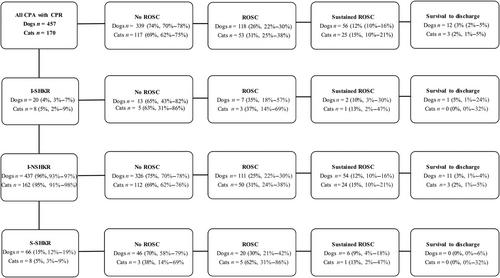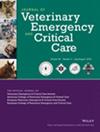Prevalence and factors associated with initial and subsequent shockable cardiac arrest rhythms and their association with patient outcomes in dogs and cats undergoing cardiopulmonary resuscitation: A RECOVER registry study
Abstract
Objective
To report the prevalence of initial shockable cardiac arrest rhythms (I-SHKR), incidence of subsequent shockable cardiac arrest rhythms (S-SHKR), and factors associated with I-SHKRs and S-SHKRs and explore their association with return of spontaneous circulation (ROSC) rates in dogs and cats undergoing CPR.
Design
Multi-institutional prospective case series from 2016 to 2021, retrospectively analyzed.
Setting
Eight university and eight private practice veterinary hospitals.
Animals
A total of 457 dogs and 170 cats with recorded cardiac arrest rhythm and event outcome reported in the Reassessment Campaign on Veterinary Resuscitation CPR registry.
Measurements and Main Results
Logistic regression was used to evaluate association of animal, hospital, and arrest variables with I-SHKRs and S-SHKRs and with patient outcomes. Odds ratios (ORs) were generated, and significance was set at P < 0.05. Of 627 animals included, 28 (4%) had I-SHKRs. Odds for I-SHKRs were significantly higher in animals with a metabolic cause of arrest (OR 7.61) and that received lidocaine (OR 17.50) or amiodarone (OR 21.22) and significantly lower in animals experiencing arrest during daytime hours (OR 0.22), in the ICU (OR 0.27), in the emergency room (OR 0.13), and out of hospital (OR 0.18) and that received epinephrine (OR 0.19). Of 599 initial nonshockable rhythms, 74 (12%) developed S-SHKRs. Odds for S-SHKRs were significantly higher in animals with higher body weight (OR 1.03), hemorrhage (OR 2.85), or intracranial cause of arrest (OR 3.73) and that received epinephrine (OR 11.36) or lidocaine (OR 18.72) and significantly decreased in those arresting in ICU (OR 0.27), emergency room (OR 0.29), and out of hospital (OR 0.38). Overall, 171 (27%) animals achieved ROSC, 81 (13%) achieved sustained ROSC, and 15 (2%) survived. Neither I-SHKRs nor S-SHKRs were significantly associated with ROSC.
Conclusions
I-SHKRs and S-SHKRs occur infrequently in dogs and cats undergoing CPR and are not associated with increased ROSC rates.


 求助内容:
求助内容: 应助结果提醒方式:
应助结果提醒方式:


